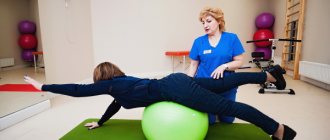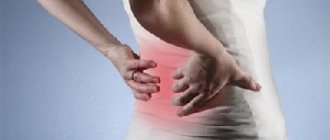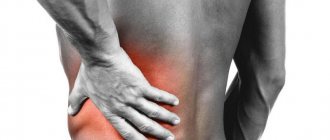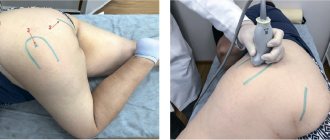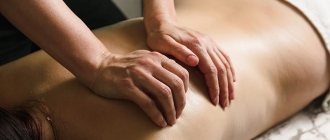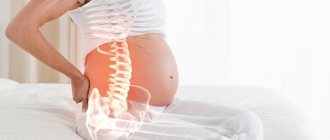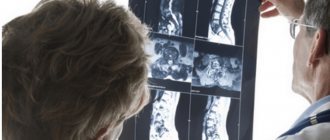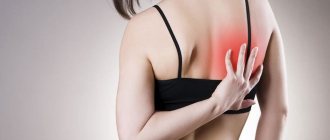Normally, a person’s muscles are either completely tense or completely relaxed. The degree of muscle tension is controlled, thanks to which a person is able to perform any action: from heavy physical exercise to delicate work under a microscope. Muscle spasm, or muscle block, is a muscle condition in which a section of the muscle is in constant tension and is not controlled by the person.
Spasms affect both individual bundles of muscle fibers and entire muscles.
The larger the muscle area in the block, the higher the intensity of the pain. A person may not even feel small spasms, but large ones can completely capture attention - a person will not be able to concentrate on anything other than the cramped muscle.
Causes
When they talk about muscle blocks, they usually mean tension in the muscles of the neck and back: trapezius, rhomboid major, quadratus lumbar, latissimus dorsi and others. Back muscle spasms occur with the following pathologies:
- Severe stress.
Stress affects the functioning of the endocrine system, which causes an increase in muscle tone. - Spinal injuries.
With spinal bruises, a trigger point may be affected - the area of the muscle that is most sensitive to irritants, and when squeezed, severe pain occurs. - Chronic overexertion.
Appears when the back is incorrectly positioned during prolonged sitting or standing work. Also, overstrain of the back muscles occurs when constantly carrying a bag on one shoulder. - Osteochondrosis
and its complications - protrusions and hernias. With osteochondrosis, nerve tissue is pinched, which causes spasms in the muscles.
The main causes of lumbar muscle spasm
There are various causes of lumbar muscle spasm, among them are pathologies of the spinal column, exposure to external negative factors, diseases of the internal organs of the abdominal cavity and pelvis, disorders of innervation and blood supply (neuropathy and angiopathy).
The main factors of external negative impact are:
- heavy physical labor, which is associated with prolonged standing, lifting or carrying heavy objects, long-term fixation of the body in a static position;
- low ambient temperature and cold draft, spasm of the capillary blood supply network in the thickness of the muscles occurs, which leads to ischemia of myocytes and the development of an acute inflammatory reaction;
- injuries (bruises, blows, penetrating wounds of muscle fiber);
- incorrect organization of sleeping and working space from an ergonomic point of view;
- wearing tight, constricting clothing.
Among pathologies of the spinal column, spasm of the lumbar muscles is most often caused by degenerative dystrophic changes in the intervertebral discs. The lumbosacral spine bears a colossal mechanical and shock-absorbing load from any movement of the human body. Therefore, cartilage discs are subject to increased destruction here. Leading a sedentary lifestyle, combined with smoking and excess body weight, leads to disruption of the process of diffuse nutrition. The annulus fibrosus of the disc becomes dehydrated and takes fluid from the nucleus pulposus located inside it. It, in turn, ensures normal height of the intervertebral disc and a sufficient level of protection for the radicular nerves extending from the spinal cord.
With protrusion, the height of the intervertebral discs decreases and this creates a number of problems:
- instability of the position of the vertebral bodies occurs, since the disc fixes them at a certain distance from each other;
- periodic slippage of the vertebrae occurs, such as retrolisthesis or antelesthesis;
- the hard shells of the spinal cord are injured; with a total displacement of the vertebral body, spinal canal stenosis can develop;
- the blood supply to the surrounding paravertebral muscles is disrupted due to spasm of the blood vessels;
- compression of the radicular nerves by adjacent vertebral bodies and resulting hernias leads to inflammation and partial atrophy of the nerve fiber;
- intervertebral joints (facet and facet) are destroyed.
In order to reduce the negative consequences of all the described pathological processes, automatic tension of the muscle fiber occurs in the lesion of the intervertebral discs. The muscular frame tries to compensate for the insufficient height of the damaged disc. In this case, the muscle fiber is overstrained, it spasms and can no longer relax on its own.
Other potential causes of lumbar muscle spasm include the following pathologies:
- distortion of the pelvic bones and short leg syndrome;
- deforming osteoarthritis of the knee, hip or iliosacral joint;
- curvature of the spinal column and changes in posture;
- multiple or polyhydramnios pregnancy;
- sprains and tears of muscles, ligaments and tendons;
- accumulation of lactic acid in the muscle fiber (most often this occurs during improperly organized training);
- inflammatory processes in the abdominal cavity;
- gynecological diseases in women and prostate pathologies in men;
- lesions of the lumbosacral nerve plexus;
- inflammation of the spinal cord, tuberculosis of the spinal column;
- development of tumor processes, both malignant and benign.
Only an experienced vertebrologist or neurologist can detect and eliminate all potential causes. These doctors have sufficient professional competence to conduct full diagnostics and develop individual courses of treatment.
Treatment of muscle spasms
For warming up, regular exercises from physical therapy or yoga are suitable. You can also sign up for a massage room. At first, during warm-ups, painful sensations are possible.
If muscle mobility is impaired, and the pain during warm-up does not go away within the first 2-3 days, be sure to consult a doctor. You should also consult a doctor if you experience a feeling of numbness, weakness and tingling in the muscles. The doctor will conduct an examination, make a diagnosis and select the correct treatment.
What problems with the spine can massage cure?
Massage is not just a pleasant procedure that allows you to relax muscles and improve blood circulation. There are therapeutic massage techniques aimed at restoring the mobility of individual segments of the spine and eliminating the symptoms of diseases.
Indications for the procedure are:
- Chronic back pain associated with sedentary work and a sedentary lifestyle;
- Migraine;
- Neck pain, decreased mobility;
- Numbness and weakness in the upper and lower extremities;
- A diagnosis of osteochondrosis of any part of the spine has been made.
Therapeutic massage for osteochondrosis helps prolong remission, eliminate unpleasant symptoms, slow down the development of the disease, and also prevent muscle atrophy.
Osteochondrosis appears due to abrasion of the intervertebral discs. The cartilage between the vertebrae becomes thinner as a result of various factors: stress, infection, high physical activity. This diagnosis is increasingly being made to young people aged 25-30. The reason for this is a sedentary lifestyle, a long stay in one position (often incorrect) at the computer .
Osteochondrosis is a chronic disease. Few people manage to restore cartilage tissue after destruction, but the course of the disease can be slowed down if you use classical types of massage, physical therapy and take medications as prescribed by your doctor.
Stooping, curvature of the spine, and incorrect body position during sleep also increase the likelihood of osteochondrosis. The disease cannot be ignored. Lack of proper treatment will lead to the formation of hernias, as well as impaired blood circulation in the brain (with osteochondrosis of the cervical spine).
Diet for cramps
The foods consumed have a great impact on the functioning of internal organs and the condition of the body. If you experience painful cramps periodically, your body may be trying to let you know that you're doing something wrong.
Review your diet and give up unhealthy foods. First of all, you need to eat at the table and in a comfortable position to minimize the strain on your back.
Consuming lean meat will be very beneficial not only for the musculoskeletal system, but also for the whole body. Avoid very fatty foods in favor of boiled ones.
Vegetables and fruits with a large amount of nitrates can cause serious harm during the treatment of chronic diseases such as rheumatism or osteochondrosis.
Massage technique
The specialist must interview the patient, clarify the diagnosis, symptoms, and tell about contraindications. The procedure is performed lying on the stomach (if a massage of the neck and shoulders is required, the patient sits with his back to the specialist and rests his hands on the table). The massage always starts from the part of the back where the pain is least severe.
Massage includes several basic techniques:
- Stroking . The massage therapist gently strokes the skin without pressing hard to warm it up and prepare it for more intense treatment. A therapeutic massage session begins and ends with such actions.
- Rubbing . They help increase blood flow to the massaged area of the body, as a result, the tissues are better saturated with oxygen. Rubbing also helps reduce pain.
- Kneading . With the help of kneading, the specialist affects not only the skin and muscles, but also the tendons. Such a deep impact allows you to improve the mobility of the vertebrae and tendons.
- Effleurage . The massage therapist intensively affects the area affected by osteochondrosis, which improves blood circulation and increases muscle tone.
Classic manual massage can be supplemented with cupping or reflexology to achieve better results. If severe pain, burning or other unpleasant sensations occur during the procedure, you should immediately inform the specialist .
Acupressure can be used to treat back pain. The specialist influences acupuncture points to relieve pain and speed up the process of tissue repair. Thanks to acupressure, muscle spasms can be relieved.
It is better to entrust the procedure to a professional who knows the characteristics of muscle tissue, the location of cartilage, nerve endings and controls the force of pressure. If you undertake to give a massage to a loved one with osteochondrosis, make sure that your manipulations will not harm him. Try to perform all movements towards the heart and not put too much pressure on the body.
For therapeutic massage, a special massage cream or oil is used, but the patient is not allergic to the components. First you need to apply a small amount of the product to your wrist and wait 5 minutes. If there is no redness, itching or burning, you can begin the massage procedure.
How is lumbar massage performed?
If osteochondrosis has affected the lumbar spine, you need to place the patient on his stomach and place a small cushion under the sore area. Your arms should be along your body and your head should be turned to the side. You need to try to relax as much as possible.
First, the massage therapist will warm up your lower back. He will work the massaged area with gentle rubbing movements. For the next 5 minutes, the specialist uses kneading movements that improve blood flow in the lumbar region, allowing you to stretch and warm up not only the skin, but also the muscles.
It is also necessary to treat the gluteal area near the lower back with intense circular movements. You can end the session with stroking.
How to provide first aid?
Treatment for back spasms should be prescribed by a doctor. But if you or someone close to you is faced with unbearable pain, there is an opportunity to reduce the pain.
What to do if pain catches you at the most inopportune moment? First of all, you need to lie down on a hard surface. You need to lie strictly on your back to calm the muscles and intervertebral discs.
After some time, the pain will subside. After this, you can apply warming ointment to your back. However, you should not delay your visit to a specialist.
Benefits and effects of massage
Massage has a relaxing effect on the muscles. When we experience pain, the muscles tense, numbness, a feeling of tightness, and discomfort occur. An experienced massage therapist will help eliminate muscle tension, relax muscles and improve blood circulation in the affected area.
With the help of classic therapeutic massage (provided that it is performed by a professional), you can achieve the following results:
- Restoring mobility of the affected segments of the spine;
- Removing tissue swelling;
- Elimination or reduction of pain;
- Strengthening individual muscle groups;
- Increasing the overall tone of the body;
- Improved well-being;
- Relieving chronic fatigue
A massage session lasts 30-40 minutes. The course includes 8-10 sessions, after which you need to take a break.
Features of thoracic spine massage
Osteochondrosis in this area is the most difficult to cure. It is not recommended to massage the thoracic region at home or on your own. It's better to leave this to a professional.
The procedure can be performed either lying down or sitting. If the patient is sitting, the specialist gently warms up, rubs and works the area, trying to warm up and relax the muscles. The session begins and ends with light strokes.
If the patient is lying down, a small cushion is placed under his chest. First, the specialist will warm up the skin, then rub the back muscles with longitudinal movements. The session ends with kneading.
Cases from practice
Woman, 39 years old, dispatcher.
She contacted the Clinical Center for Autonomic Neurology with complaints of stiffness in all muscles of the body. “I get up in the morning, feeling stiff, and start pacing slowly for at least an hour. But I still feel like I’m wearing a shell. And then panic begins, a terrible state for two or three hours.”
From the anamnesis: in childhood, up to the age of 18, frequent acute respiratory viral infections and otitis media.
The first panic attack happened in 2007. Five years before this incident, during pregnancy, the woman began to notice that every night she began to sleep less and less. And before giving birth there was already “24-hour insomnia.” At the same time, a feeling of chest compression appeared.
In 2010, a woman was observed in a tuberculosis clinic with a diagnosis of eosinophilic pneumonia. Every morning there are vegetative crises. I contacted a neurologist. Antidepressants were prescribed: Paxil and Cipralex. However, the treatment did not bring significant relief.
The examination revealed: diffuse muscle tension in the cervical-collar area, hyperesthesia in the back (L3 and below) on the left and the posterior surface of the leg on the left...
To get rid of the symptoms, the woman needed two courses of therapy. Over the past year there have been no complaints about health.
Woman, 29 years old, lawyer.
The peculiarity of her illness was that in the first place in the list of her complaints, the patient put “mood instability” and “emotional swings,” which many of the doctors who examined her, including well-known specialists, interpreted as personal characteristics and pathological character traits. They also viewed somatic complaints as “exaggerated” and “far-fetched.”
From the anamnesis it is known: 5 years ago, against the background of a stressful situation, nightmares began with palpitations, tachycardia, numbness of the hands, which lasted more than 2 years. In 2010, for the first time, a strong spasm of the neck muscles occurred, during which the blood pressure dropped (from the usual 140 to 90 mm Hg), for the first time I experienced an attack of severe headache, a feeling of pressure in the heart area.
For 3 months I was “saved by citramon.” I contacted a neurologist. Mydocalm was prescribed, she underwent a course of acupuncture and a pressure chamber. A period of relative prosperity ensued.
However, the symptoms soon returned. Because of this, the woman became nervous, irritable, constantly complained of weakness, and could not do anything. She was examined in medical centers in Moscow, Germany, Switzerland, including psychiatric clinics.
I contacted the Center for Autonomic Neurology in early 2011. Multiple autonomic disorders, signs of hypothalamic syndrome, and overstrain of the parasympathetic part of the autonomic nervous system were identified.
During the first course of treatment there were severe exacerbations (insomnia, nightmares, headaches, tearfulness), but by the 10th session the woman’s condition had stabilized. Currently, she feels like an absolutely healthy person (follow-up in October 2012).
Possible consequences of untreated back spasms
Often people do not pay attention to pain until it becomes unbearable. But experts do not recommend ignoring back spasms, as this can lead to bad consequences.
Self-medicating and using traditional methods can only make the situation worse.
The result can be irreversible consequences, for example, the transition of diseases such as osteochondrosis, rheumatism or kyphosis to the chronic stage or complete loss of sensitivity due to a vertebral hernia.
